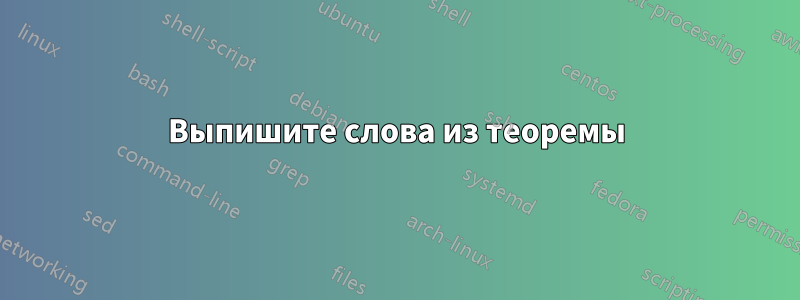
У меня есть теорема, которая звучит так:
\documentclass[12pt]{book}
\begin{document}
\newtheorem{definition}{Definition}[section]
\begin{definition}[Integers]
Integers are positive and negative whole numbers, including 0.\\
e.g. $..., -3, -2, -1, 0, 1, 2, 3, 4, ...$
\end{definition}
\end{document}

Как перенести утверждение «Целые числа бывают положительными и отрицательными...» на одну строку вниз?
Я пробовал \\, но это создаст ошибку отсутствия строки до конца и не приведет к появлению сообщения «Целые числа являются положительными и отрицательными...».
Спасибо!
решение1
Вы можете использовать amsthmи определять свои собственные стили теорем.
\documentclass[12pt]{book}
\usepackage{amsthm,amsmath}
\newtheoremstyle{breakthm}
{\topsep}% Space above
{\topsep}% Space below
{\itshape}% Body font
{}% Indent amount (empty = no indent, \parindent = para indent)
{\bfseries}% Thm head font
{.}% Punctuation after thm head
{\newline}% Space after thm head: " " = normal interword space;
{}% Thm head spec (can be left empty, meaning `normal')
\newtheoremstyle{breakdef}
{\topsep}% Space above
{\topsep}% Space below
{\upshape}% Body font
{}% Indent amount (empty = no indent, \parindent = para indent)
{\bfseries}% Thm head font
{.}% Punctuation after thm head
{\newline}% Space after thm head: " " = normal interword space;
{}% Thm head spec (can be left empty, meaning `normal')
\theoremstyle{breakthm}
\newtheorem{theorem}{Theorem}[section]
\theoremstyle{breakdef}
\newtheorem{definition}[theorem]{Definition}
\begin{document}
\begin{definition}[Integers]
Integers are positive and negative whole numbers, including $0$,
e.g.
\[
\dots, -3, -2, -1, 0, 1, 2, 3, 4,\dotsc
\]
\end{definition}
\begin{theorem}
The integers are useful.
\end{theorem}
\end{document}

Но, по моему мнению, это просто пустая трата места.
Обратите внимание, что это amsthmобеспечивает гораздо лучшие возможности настройки. С theorem(или, лучше, ntheorem) вам придется определить новый стиль теоремы, если вы хотите, чтобы шрифт тела в определениях был вертикальным, что является обычным.
Другая возможность — использовать thmtools, что делает определение новых стилей теорем довольно простым. То же самое, что и раньше, можно получить с помощью
\documentclass[12pt]{book}
\usepackage{amsmath,amsthm,thmtools}
\declaretheoremstyle[
postheadspace=\newline,
bodyfont=\itshape,
]{breakthm}% main style
\declaretheoremstyle[
style=breakthm,
bodyfont=\normalfont,
]{breakdef}% override the bodyfont
\declaretheorem[
name=Theorem,
style=breakthm,
numberwithin=section,
]{theorem}
\declaretheorem[
name=Definition,
style=breakdef,
numberlike=theorem,
]{definition}
\begin{document}
\begin{definition}[Integers]
Integers are positive and negative whole numbers, including $0$,
e.g.
\[
\dots, -3, -2, -1, 0, 1, 2, 3, 4,\dotsc
\]
\end{definition}
\begin{theorem}
The integers are useful.
\end{theorem}
\end{document}
решение2
Существует множество пакетов для настройки теорем, в том числе theoremв основном дистрибутиве Latex:
\documentclass[12pt]{book}
\usepackage{theorem}
\theoremstyle{break}
\newtheorem{definition}{Definition}[section]
\begin{document}
\begin{definition}[Integers]
Integers are positive and negative whole numbers, including 0.\\
e.g. $..., -3, -2, -1, 0, 1, 2, 3, 4, ...$
\end{definition}
\end{document}


